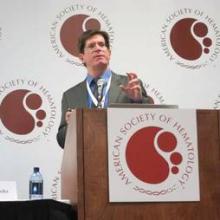ATLANTA – Survival was not enhanced among children with blood cancers after transplantation with two units of umbilical cord blood versus an adequately dosed single-unit transplant.
Among 224 children in a phase III study, overall survival at 1 year was 71% with a single-unit umbilical cord blood (UCB) transplant and 65% with a double-unit UCB transplant (P = .13).
All other outcomes were similar, except for a lower incidence of platelet recovery and higher incidence of grade III-IV acute graft-versus-host disease after double UCB transplants, Dr. John E. Wagner reported on behalf of the Blood and Marrow Transplant Clinical Trials Network at the annual meeting of the American Society of Hematology.
And for patients who don’t have an adequate single cord unit based on cell dose, "a double cord blood unit was certainly as good as, or an acceptable alternative, to the single," he said. "So it allowed us to extend the transplant experience."
One of the major shortcomings of UCB transplantation is that units containing a minimum of 2.5 x 107 total nucleated cells/kg of patient body weight are frequently unavailable. The optimal number of transplanted umbilical stem cells remains unclear, but cell dose is an important factor influencing engraftment, or the ability of cells to take root, and survival.
Pilot studies suggested that infusion of two partially HLA-matched UCB units is safe, leading investigators to hypothesize that higher cell doses achieved with double UCB transplant would translate into improved survival, explained Dr. Wagner, scientific director of clinical research for the adult and pediatric blood and bone marrow transplant program at the University of Minnesota Medical Center in Minneapolis.
Between December 2006 and February 2012, investigators at 32 transplant centers enrolled 224 patients, aged 1-21 years, with acute lymphoblastic leukemia (ALL), acute myeloid leukemia, natural killer cell leukemia, chronic myeloid leukemia, or myelodysplastic syndrome. All had at least two available UCB units – each at least 4 of 6 HLA-matched to the patient and 3 of 6 matched between units.
Patients were randomized to receive a conventional single UCB (n = 113) or double UCB (n = 111) transplant. In all, 2.7% of the single UCB group and 1% of the double UCB group crossed over to the opposite arm. Only 1.8% of patients in both groups were not transplanted.
The groups were well matched for age, gender, race, performance status, and disease status. A little more than half of all patients had ALL.
After a median follow-up of 25 months, 92% of patients were in remission, with 60% of these in a second or subsequent remission.
Neutrophil counts had recovered at day 42 in 86% of the double UCB group and in 89% of the single UCB group (P = .08). Platelet recovery at 6 months was significantly lower after double UCB transplant (66% vs. 76%; P = .04), Dr. Wagner said.
Rates were nearly identical in the single and double UCB groups for grade II-IV acute graft-versus-host-disease at 100 days (56% vs. 57%; P = .88) and for chronic GVHD at 1 year (28% vs. 31%; P = .60), although a subpopulation in the double UCB group was significantly more likely to experience grade III-IV acute GVHD (23% vs. 14%; P = .04).
More importantly, there was a very low risk of transplant-related relapse after double or single UCB transplant (14% vs. 12%; P = .37), he observed.
Disease-free survival at 1 year was also similar in the double and single UCB groups at 64% vs. 68% (P = .22).
Dr. Wagner said the average total nucleated cell doses of 3.9 x 107 in the single UCB group and 7.2 x 107 in the double UCB group were not adequate for detecting differences in overall survival. "It probably will take a much greater dose escalation to be able to see that [difference]," he said.
Still, he noted that the overall survival and engraftment rates seen in both arms are superior to what was expected based on historical data sets, including the Cord Blood Transplantation Study (COBLT). It reported cumulative incidences for neutrophil recovery and platelet engraftment of 80% and 50%, and an overall survival of 67.4% in children with hematologic malignancies, despite a median cell dose of 5.1 x 107 (Blood 2008;112:4318-27).
One possible explanation, he suggested, is a new conditioning regimen that includes 1,320 cGy of total body irradiation and cyclophosphamide 120 mg/kg, but replaces the equine antithymocyte globulin used in the COBLT study with fludarabine (Fludara) 75 mg/m2. All patients also received cyclosporine and mycophenolate mofetil for GVHD prophylaxis.


